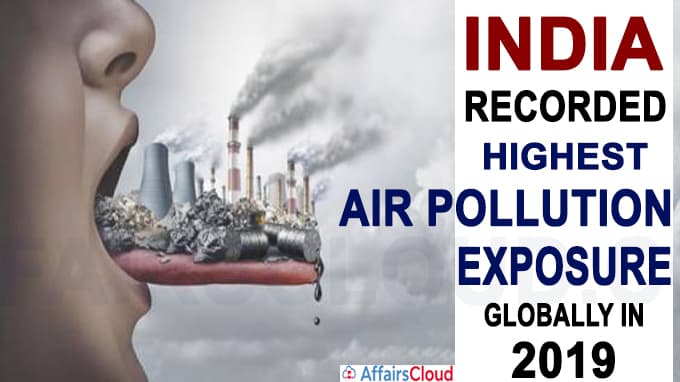 On October 20, 2020, the 3rd State of Global Air 2020 (SOGA 2020) report was released by United States (US)-based Health Effects Institute (HEI) and Institute for Health Metrics and Evaluation’s (IHME) Global Burden of Disease (GBD) Project in which India recorded the highest annual average PM 2.5 concentration exposure in the world in 2019 followed by Nepal (2nd), and Niger (3rd). The report used data from ground monitors and satellites to make their assessments.
On October 20, 2020, the 3rd State of Global Air 2020 (SOGA 2020) report was released by United States (US)-based Health Effects Institute (HEI) and Institute for Health Metrics and Evaluation’s (IHME) Global Burden of Disease (GBD) Project in which India recorded the highest annual average PM 2.5 concentration exposure in the world in 2019 followed by Nepal (2nd), and Niger (3rd). The report used data from ground monitors and satellites to make their assessments.
- India is also among the top ten countries with highest ozone (O3) exposure in 2019. Qatar recorded the highest O3 exposure followed by Nepal and India.
- Among the 20 most populous countries, India recorded the highest increase (17%) in O3 concentrations in the past ten years.
- India had the highest burden of infant deaths due to air pollution followed by Nigeria (67,900), Pakistan (56,500), and Ethiopia (22,900). Over 116,000 infants in India died within a month after their birth due to exposure to severe air pollution in 2019.
Number of people exposed to household air pollution reduced in India:
Notably, India has managed to reduce the number of people exposed to household air pollution from 73% to 61% over a period of 10 years because of Pradhan Mantri Ujjwala Yojana (PMUY), Household LPG (Liquefied petroleum gas) programme and other schemes that have expanded access to clean energy, especially for rural households.
Key Points:
— Long-term exposure to outdoor and household air pollution contributed to over 6.7 million annual deaths globally, including 1.67 million in India.
–Of all neonatal deaths attributable to air pollution globally, household air pollution accounted for about 64% of them.
— On average, global exposure to ozone increased from about 47.3 parts per billion (ppb) in 2010 to 49.5 ppb in 2019.
— Out of 87 health risk factors based on the total number of deaths caused in 2019 assessed by the team, air pollution has the fourth highest risk globally preceded by high systolic blood pressure, tobacco and dietary risks.
–India has been recording an increase in PM 2.5 pollution since 2010
–Out of the 20 most populous countries, 14 have recorded a gradual improvement in air quality but India, Bangladesh, Niger, Pakistan and Japan are among those that have recorded a modest increase in air pollution levels.
Click Here for Official Report
Recent Related News:
i.On September 11, 2020, The latest report for revised GDP forecast FY 21 by CARE Ratings Limited-CARE ( formerly Credit Analysis and Research Limited) projected India’s GDP (Gross Domestic Product) to contract by 8.0 – 8.2%(-8.0% to -8.2%) in FY 21.
ii.On September 22, 2020 Small Industries Development Bank of India (SIDBI) partnered with CRIF High Mark Credit Information Services(CRIF High Mark), a leading Indian credit bureau owned by CRIF to launch ‘Industry Spotlight’, a quarterly report based on Industry sectors/ clusters, with focus on MSMEs(Micro, Small and Medium Enterprises).
Static Points:
i.O3 is a major respiratory irritant which is not released directly into the air but is formed in a complex chemical interaction between nitrogen oxides (NOx) and volatile organic compounds (VOCs) in the presence of sunlight.
ii.NOx is emitted from the burning of fossil fuels (oil, gas, and coal) in motor vehicles, power plants, industrial boilers, and home heating systems.
iii.Volatile organic compounds are also emitted by motor vehicles, as well as by industrial activities.




